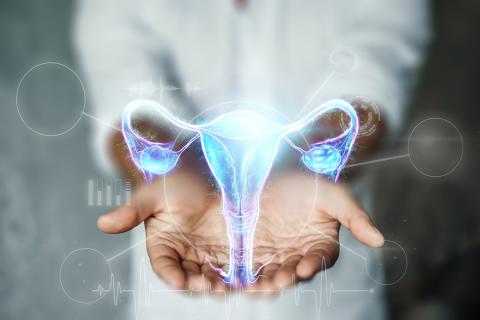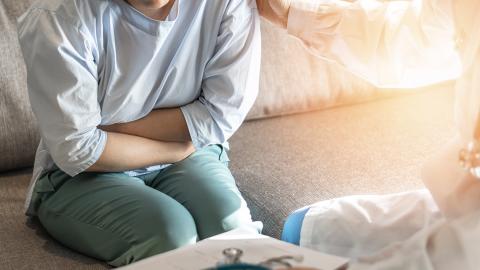Women Affected More
Pelvic Floor PSA
Between a quarter and half of all women may experience pelvic floor issues, yet many accept it as a fact of life or feel embarrassed about seeking help. How do we improve outcomes?
Pelvic Floor Disorders

Pelvic floor disorders (PFD) are a broad range of conditions affecting the pelvic organs such as the bladder, bowels and reproductive tract. These conditions include urinary leakage or frequency, urinary or fecal incontinence, and pelvic organ prolapse. PFDs can affect both men and women. While PFDs typically do not cause physical harm if untreated, they are associated with depression and anxiety and may significantly impact the individual’s quality of life.
Many women likely deal with some degree of PFDs, especially if they have given birth. Aging also increases the likelihood of experiencing symptomatic PFD. The decrease in estrogen that comes with menopause may contribute to weakening and loss of strength in the pelvic floor muscles. Other risk factors for these conditions include conditions that cause excess or chronic straining, such as constipation and obesity, or extremely high-intensity workouts such as heavy weightlifting.

“Pelvic floor disorders are often dismissed as a ‘normal’ part of aging, but it’s not something you have to live with. Treatments do exist,” said Dr. Donna Mazloomdoost, a urogynecologist and medical officer with the Eunice Kennedy Shriver National Institute of Child Health and Human Development (NICHD) Gynecologic Health and Diseases Branch (GHDB). Her main research areas involve pelvic floor disorders, obstetric fistula and female genital mutilation. She started her career as an obstetrician/gynecologist and became interested in urogynecology as a subspecialty due to the large prevalence of women with PFDs she encountered in her practice.
PFDs are more likely to occur with aging, but younger women can also develop them. “There are no good estimates on the actual prevalence,” Mazloomdoost lamented. “PFDs are probably more widespread [than we realize] because women may not report them due to embarrassment or beliefs that they are not treatable.”
Pelvic Floor Dysfunction
Another affliction of the pelvic floor is called pelvic floor dysfunction. Women with the condition may have excessively tight pelvic floor muscles that may also contribute to other symptoms such as constipation, frequent urinary urges, pain with intercourse or pelvic pain. The muscle spasms are called levator hypertonus, and this condition is distinct from PFDs because the former causes pain, whereas PFDs are uncomfortable but not typically associated with pain.
Treatment

Photo: MARIDAV/SHUTTERSTOCK
The first line of treatment for PFDs and dysfunction is often pelvic floor physical therapy. Pelvic floor exercises can help patients with PFD improve muscle tone and function. Pelvic floor physical therapy often focuses on pelvic muscle relaxation and retraining, or even a specific massage called myofascial release in cases of levator hypertonus. A supportive device such as a pessary can be used to treat pelvic organ prolapse (a hernia that develops in the vagina causing the pelvic organs to drop from their position and bulge into or out of the vagina). Medications can also be used to treat many of these conditions. Surgery may be beneficial for some pelvic floor conditions.
Stigma
Pelvic floor disorders and dysfunction often come with stigma. PFD symptoms such as urinary incontinence after giving birth may seem like a fact of life or may feel like a low-priority issue to a new mom. Symptoms can also be embarrassing. Patients who experience pelvic floor conditions may be reluctant or embarrassed to discuss their symptoms with their doctor. Furthermore, non-specialized gynecologists may not be trained to treat pelvic floor conditions, and a urogynecologist may not always be available in the region.
Urogynecology is a relatively new board-certified subspecialty, so patients may not even know what resources are available to them, and doctors who do not specialize in the field may not know where to refer patients.
“Ending up on the right doorstep is the biggest hurdle,” Mazloomdoost said. She still sees patients in addition to her NICHD work, and she said women often suffered symptoms for three to eight years before seeking treatment.
Pain Disorders
Sometimes, women can experience pelvic pain with no visible or obvious cause. The pain may intersect with pelvic floor dysfunction, but that is not always the sole cause.
Dr. Helena Ahn is a GHDB program officer who oversees grants related to gynecologic pain, including chronic pelvic pain, endometriosis-associated pain, dysmenorrhea (menstrual pain), dyspareunia (pain with intercourse) and vulvodynia (chronic pain around the vulva/vaginal opening).

A neurobiologist by training, Ahn said so much of what she learned about gynecologic pain was new and interesting to her.
“It is surprising that many women are suffering from gynecologic pain and yet we don’t have much knowledge about these conditions,” she noted. “Most people don’t feel comfortable talking about their gynecologic pain conditions, which may delay the proper pain management or treatment.”
Chronic pelvic pain syndrome is estimated to affect nearly 15 percent of the general population and is associated with decreased quality of life, loss of productivity and increased health care use. Also, treatment is costly: Women with chronic pelvic pain spend roughly $881.5 million yearly in direct health care costs, and the overall cost is roughly $2 billion.
Researchers do have some idea of what contributes to chronic vulvovaginal pain, and the sources are myriad:
- injury or irritation to the nerves that supply feeling to the vulva
- an increase in nerve endings or inflammatory markers in the vulvar skin
- abnormal response of the vulvar cells to environmental factors
- changes to hormone receptors in the vulva
- genetic factors
- localized hypersensitivity to yeast or other microorganisms
- weakness or spasm of the pelvic floor muscles
GHDB aims to improve women’s reproductive health by guiding and supporting gynecologic research. One of the branch’s research priorities is to understand the mechanisms of chronic gynecologic pain. There is limited understanding of the prevalence, biological mechanisms and clinical risk factors responsible for the development of gynecologic pain syndromes. More vigorous basic, clinical, and translational research is needed, particularly considering the urgent need for effective and safe non-opioid options for pain management.
Understudied
Most grants Ahn sees are focused on pain related to menstruation or endometriosis—both worthy causes—but the lack of awareness about the most stigmatized gynecologic pain conditions leave millions of patients without adequate resources.

Photo: CHINNAPONG/SHUTTERSTOCK
“Gynecologic pain is a very understudied and underfunded research area. Across NIH, gynecologic pain received far less funding in fiscal year 2022 ($6.5M) when compared to pain research ($978M), back pain ($66M) or headache ($54M),” Ahn said.
GHDB organized the NICHD Gynecologic Pain Virtual Meeting in 2022 and 2023 to bring together investigators in the field of gynecology and pain to spur interest, share ideas and discuss challenges, gaps and future directions in gynecologic pain research. Those meetings provided opportunities for investigators to network and collaborate, leading to new grant proposals.
Ahn has noticed the power of this increased awareness: “Interest in gynecologic pain is growing. The number of grant applications and awarded grants related to gynecologic pain has been increasing recently.”
Knowledge Is Power
Despite this increase in interest, there is still much we don’t know about what causes changes to the pelvic floor and its component structures.
“If we could understand the causes then we could better direct treatment,” Mazloomdoost said.
Advocacy from both patients and practitioners is crucial, Mazloomdoost and Ahn emphasized. They are also feeling heartened by the recent White House Initiative on Women’s Health Research, and Executive Order on Advancing Women’s Health Research and Innovation, which aims to overhaul how the U.S. approaches and funds research on women’s health.
Mazloomdoost also has a message for women who are currently experiencing pelvic floor conditions: “We’ve come a long way in our understanding—we have treatments now that we didn’t have 20 years ago.”
Perhaps most importantly, though: “Don’t lose hope,” she concluded. “Things often get better once the appropriate condition is diagnosed.”
